

Roderick Murchison. Sir Roderick Impey Murchison, 1st Baronet KCB DCL FRS FRSE FLS PRGS PBA MRIA (22 February 1792[1] – 22 October 1871) was a Scottish geologist who first described and investigated the Silurian system.
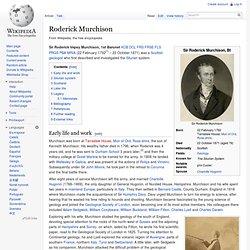
Early life and work[edit] After eight years of service Murchison left the army, and married Charlotte Hugonin (1788–1869), the only daughter of General Hugonin, of Nursted House, Hampshire. Murchison and his wife spent two years in mainland Europe, particularly in Italy. They then settled in Barnard Castle, County Durham, England in 1818 where Murchison made the acquaintance of Sir Humphry Davy. Davy urged Murchison to turn his energy to science, after hearing that he wasted his time riding to hounds and shooting. Sir Roderick Murchison Feature Page on Undiscovered Scotland. Sir Roderick Impey Murchison KCB FRS, 1st Baronet, lived from 19 February 1792 to 22 October 1871.
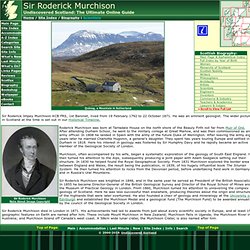
He was an eminent geologist. The wider picture in Scotland at the time is set out in our Historical Timeline. Overview of Sir Roderick Impey Murchison. Murchison. MURCHISON, softened from Murdockson, the name of a minor clan in Lochalsh, Ross-shire, in Gaelic called Eilan Calmaon, it is supposed from their being long the governors of Eilean Donnan Castle, the place where Donald Gorme of Sleat met his death in 1539.
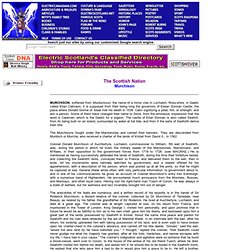
Calm signifying a pillar, fort, or strength, and aon a person. Some of them have changed their name to Dove, from the erroneous impression that the word is Calaman, which is the Gaelic for a pigeon. The castle of Eilan Donnan is also called Seafort, from its being built on an island, surrounded by water at full tide, and from it the earls of Seaforth derive their title. The Murchisons fought under the Mackenzies and carried their banners. They are descended from Murdoch or Murcha, who received a charter of the lands of Kintail from David II., in 1362.
Sir Roderick Impey Murchison. Sir Roderick Impey Murchison, 1st Baronet, KCB, DCL, FRS, FRSE, FLS, PRGS, PBA, and MRIA, pause for breath; the geologist and geographer who established the Silurian and Devonian systems, and predicted the discovery of gold in Australia, died on the 22nd of October, 1871.
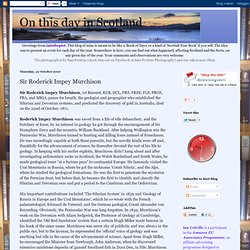
Edinburgh Geological Society. Murchison in Bohemia translated by Radvan Horny If a spectacular comet appears on the horizon, then the whole population is transfixed by the force of Nature and delights in seeing the phenomenon before it disappears.
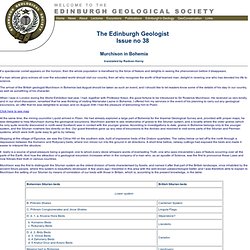
If a man whose glory echoes all over the educated world should visit our country, then all who recognise the worth of that learned man, delight in revering one who has devoted his life to science. Rocky Road: Roderick Impey Murchison. Roderick Impey Murchison From The Great Devonian Controversy by Martin J.S.

Rudwick Among the best known geologists of his time, Roderick Impey Murchison had no aversion to fame, wealth, priority or mixing with European nobility. He also had a well-earned reputation for browbeating his colleagues. Murchison named the Silurian, now understood to be one of the earlier rock formations deposited in the Paleozoic Era. From moderately wealthy Scottish roots, Murchison moved on to the army, though it has been suggested that he somewhat overstated his military accomplishments later in life. Sir Roderick Impey Murchison Facts. The British geologist Sir Roderick Impey Murchison (1792-1871) established the Silurian as a new geological system and cofounded the Devonian system.
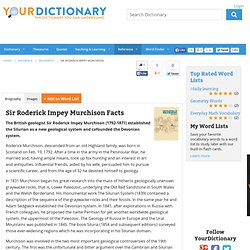
Roderick Murchison, descended from an old Highland family, was born in Scotland on Feb. 19, 1792. After a time in the army in the Peninsular War, he married and, having ample means, took up fox hunting and an interest in art and antiquities. Influential friends, aided by his wife, persuaded him to pursue a scientific career, and from the age of 32 he devoted himself to geology. Roderick Impey Murchison - Countryside Council for Wales. Sir Roderick Impey Murchison, who endowed the prestigious Murchison medal, was a pioneering geologist who made an important early contribution to the subdivison of geological time, thus laying the foundations for our modern stratigraphical scheme.
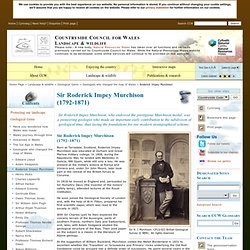
Sir R. I Murchison. CP13/023 British Geological Survey © NERC. All rights reserved. Professor of geology, University of Edinburgh. Sir Roderick Impey Murchison was born into a wealthy Highland family.
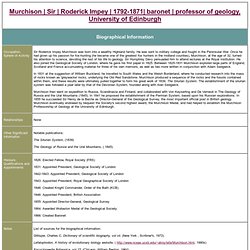
He was sent to military college and fought in the Peninsular War. Murchison, Sir Roderick Impey. Sir Roderick Murchison. Sir Roderick Murchison was a famous Scottish Geologist, born in Tarrodale, Easter Ross in the Scottish Highlands in 1792.

He was the David Attenborough of he’s day. As a young adult he spent many years in an English military college before joining the army for 8 years as an Officer. Roderick Murchison - David Livingstone's Friends. Sir Roderick Impey Murchison, 1st Baronet KCB DCL FRS FRSE FLS PRGS PBA MRIA (22 February 1792] – 22 October 1871) was a Scottish geologist who first described and investigated several of the Ages of the Earth, then as president of the Geographical Society He supported much exploration work, including that of David Livingstone, who dedicated his first book to Murchison and counted him one of his best friends.
They exchanged many letters. Lurian : Overview. Sir Roderick Impey Murchison Quotes - 9 Science Quotes - Dictionary of Science Quotations and Scientist Quotes. Science Quotes by Sir Roderick Impey Murchison (7 quotes) Combining in our survey then, the whole range of deposits from the most recent to the most ancient group, how striking a succession do they present:– so various yet so uniform–so vast yet so connected. In thus tracing back to the most remote periods in the physical history of our continents, one system of operations, as the means by which many complex formations have been successively produced, the mind becomes impressed with the singleness of nature's laws; and in this respect, at least, geology is hardly inferior in simplicity to astronomy. — Sir Roderick Impey Murchison The Silurian System (1839), 574. During cycles long anterior to the creation of the human race, and while the surface of the globe was passing from one condition to another, whole races of animals–each group adapted to the physical conditions in which they lived–were successively created and exterminated.
Siluria (1854), 5. Siluria (1872), 476. Siluria (1854), 469. Sir Roderick Impey Murchison correspondence, 1829-1871. Background note Sir Roderick Impey Murchison (1792-1871, APS 1860), geologist, geographer, and advocate of exploration, devoted the bulk of his scientific career to stratigraphy and promoting a catastrophist view of geological change. The Silurian System (1839) was a milestone work exploring fossil-bearing strata in Wales and western England, and The Geology of Russia and the Ural Mountains (1845, with Alexander von Keyserling and Edouard de Verneuil) established the Permian System. Murchison’s scientific career was littered with theoretical, personal, and political disputes; most significant were rivalries with Charles Lyell and Adam Sedgwick regarding, respectively, uniformitarianism and the Cambrian-Silurian boundary. Murchison was an advocate of imperial expansion and exploration; he viewed science as a nationalistic endeavor. The Murchisons were a highland clan, stripped of their lands after participating in the 1715 and 1745 rebellions.
T. Edmund W. Leroy E. Henry C. NAHSTE: Papers of Sir Roderick Impey Murchison. Sir Roderick Impey Murchison (1792-1871), developed the modern classification of the Palaeozoic period, through his research emphasising biostratigraphy; the deposition of strata indicated by fossils. In the course of his career he successively defined the Silurian, Devonian and Permian strata, which replaced Greywacke and Coal Measures in the scientific literature. After serving with the army in the Peninsula War and a period of time pursuing his interest in hunting, the independently wealthy Murchison began attending lectures at the Royal Institution. In 1825 he joined the Geological Society of London. The Urals remember Sir Roderick Murchison. The memorial was installed through the efforts of the Ural-Scottish Society, an organisation set up in Yekaterinburg in January.
The “Ural Scots” describe their mission as fostering cultural and spiritual bonds between the two peoples, creating a common information environment, and sharing knowledge, ideas and expertise between Russia and Scotland. Murchison was an academic icon in the 19th century. Sir Roderick Impey Murchison, 1792 - 1871. Geologist − Henry William Pickersgill − P. Mezzotint Mezzotint is a method of producing prints that was developed in the seventeenth century. Sir Roderick Impey Murchison, 1792 - 1871. Geologist − William Walker − W. Mezzotint Mezzotint is a method of producing prints that was developed in the seventeenth century. A metal printing plate is roughened by scratching a tool across the surface to leave an even burr.
When ink is applied to the plate, the burr holds it, and if a sheet in this state is printed at this stage, the resulting impression is entirely black. An image is created by smoothing parts of the abraded surface so that when ink is applied, the smoother areas do not have such a strong ink-holding capacity, and therefore do no leave such a dark impression. A mezzotint printmaker, therefore, works from dark to create light. Royal Geographical Society The Geographical Society of London was founded in 1830 as an institution to promote the advancement of geographical science. Royal Institution. Your Paintings - Sir Roderick Impey Murchison, 1st Bt. Sir Roderick Impey Murchison, 1st Bt. The Library of Nineteenth-Century Photography - Sir Roderick Murchison. Portrait - NPG Ax17793; Sir Roderick Impey Murchison, 1st Bt.